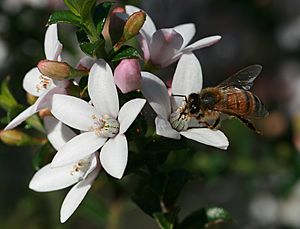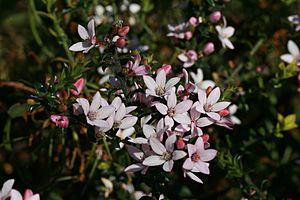Philotheca buxifolia facts for kids
Quick facts for kids Philotheca buxifolia |
|
|---|---|
 |
|
| Scientific classification | |
| Genus: |
Philotheca
|
| Species: |
buxifolia
|
| Synonyms | |
|
Eriostemon buxifolius Sm. |
|
The Philotheca buxifolia is a beautiful flowering plant that belongs to the Rutaceae family. This plant is special because it is endemic to New South Wales, Australia. This means it naturally grows only in that area!
It is a type of shrub, which is a woody plant smaller than a tree. It has leaves that are somewhat oval-shaped. Its pretty white to pink flowers grow one by one at the ends of its branches.
What Does It Look Like?
The Philotheca buxifolia is a shrub that usually grows up to about 1.3 meters (around 4 feet) tall. Its small branches have short, stiff hairs.
- Leaves: The leaves are usually round or broadly oval. They can also be egg-shaped, with the narrower part at the bottom. They are about 6 to 12 millimeters long. The base of the leaf can look like a wedge or a heart.
- Flowers: The flowers grow by themselves at the tips of the branches. Each flower sits on a small stalk, called a pedicel, which is about 2 to 4 millimeters long.
- The sepals (small leaf-like parts that protect the bud) are thick and shaped like wide triangles, about 1 to 1.5 millimeters long.
- The petals are white to pink and broadly oval, measuring about 8 to 15 millimeters long.
- Inside the flower, there are ten stamens (the parts that make pollen). They are separate from each other and have a noticeable part on their anther (the tip of the stamen).
- Flowering Time: This plant blooms from winter through spring.
- Fruit: After flowering, it produces a fruit about 7 millimeters long. This fruit has a small beak-like tip that is about 3 millimeters long.
How Scientists Name and Group It
Scientists give plants special names to help identify them. This plant was first officially described in 1809 by a scientist named James Edward Smith. He wrote about it in a book called The Cyclopaedia. He studied plants found near Port Jackson by Dr. White.
Later, in 1998, another scientist named Paul G. Wilson changed its name to Philotheca buxifolius. He also found that there are three slightly different types, or "subspecies," of this plant. These subspecies are accepted by the Australian Plant Census, which keeps track of Australian plants.
Here are the three subspecies:
- Box-leaf waxflower (subsp. buxifolia): This type has leaves that are round or broadly oval. They are not folded lengthwise and have a heart-shaped base. You can mostly find this subspecies in the Sydney area.
- Subsp. falcata: This subspecies also has round to broadly oval leaves that are not folded. Their bases are heart-shaped. This type grows only in the Jervis Bay area.
- Subsp. obovata: This kind has egg-shaped leaves, with the narrower end at the bottom. The base of the leaf is wedge-shaped. You can find this subspecies near Gosford and near Ulladulla.
Where Does It Grow?
The Philotheca buxifolia plant grows in coastal areas of New South Wales, Australia. It prefers to grow in "heath" areas, which are open lands with low-growing shrubs and plants. It especially likes to grow on sandstone soil. You can find it in the region between Gosford and Ulladulla.
See also
 In Spanish: Philotheca buxifolius para niños
In Spanish: Philotheca buxifolius para niños


